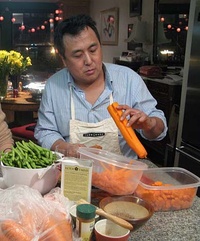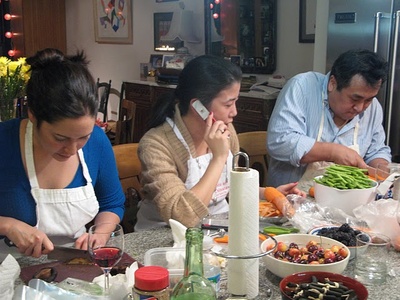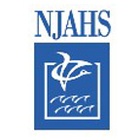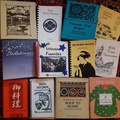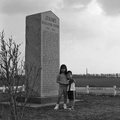When I met Julie, we shared a desire to keep our house open to our friends and community as much as possible. 1984 was our first oshogatsu as a couple. Her family did nishime. I had never heard of it before. I couldn’t imagine New Year’s without ozoni. Julie was obsessed with kuromame and chestnuts in a sweet sauce. What about those bowtie seaweed things? No self-respecting Japanese-American celebration is complete without cha siu, Chinese roast pork. We could do this.
We lived neared Manhattan’s Chinatown. We sourced some ingredients there and journeyed to various Korean and Japanese groceries in Manhattan and New Jersey to put together our first New Year’s Day celebration. The redress movement was in full bloom. We knew many Niseis and Sanseis, indigenous and transplanted. Our invitations were well received, but many of our Japanese-American friends were either holding celebrations of their own or attending those to which they held long commitments. Our attendees were a diverse group, drawn from friends and family in the area. Maybe twenty-five people came through that first year.
Twenty five years later, we are still preparing our lists, making our runs across the Hudson to the Asian markets in New Jersey and picking up some quantities of things we forgot in various Manhattan locations.
We’ve seen the community change and, with it, our celebration. It is harder to find some things in Chinatown, as the indigenous population ages and leaves. But, the rise in the number of young Japanese immigrants in the East Village has begotten Sunrise Market and JAS Mart.
The community has changed.
Over the years we have seen our Nisei friends pass away or move long distances to be closer to their children – Sanseis our own age we never knew existed. Attendance surges and deflates, year to year, depending on the weather and personal circumstances of those involved. We’ve estimated forty-five guests one year, seventy-five another. There are fewer alternative celebrations among the people we know, as the task of sourcing and preparing all the various ingredients becomes more burdensome with age, overwhelming the Nisei torchbearers.
We spend days preparing. The people who come to help seem to look forward to it. On New Year’s Eve, we can count Riki to adjust the seasoning of the dashi that flavors the nishime and David to do the fine cutting and chopping. Stann, Jennifer, and Kenji are utility sous-chefs, taking instruction, encouragement, and criticism from Julie. They get their hands wet until they are wrinkled, endure various nicks and cuts, and then go off to their New Year’s Eve parties.
People who never heard of ‘striped Jell-O’ years ago, now passionately protect the responsibility of making it.
On New Year’s Day, we can expect Ginny, Teddy, and a friend or two as early as 1:00pm to roll sushi. By 3:00pm, the culinary task force may number eight to ten volunteers. Julie runs the sushi factory in our kitchen like a drill sergeant from an old war movie, also directing the cutting and plating of items, emphasizing portion strategies and visual aesthetics.
Before we know it, the doorbell is ringing, people are arriving. Dishes come into the kitchen empty and go out again full. The contents of half-empty platters get placed on half-full platters. Guests bring food that needs to be heated and plated. Bottles of wine arrive in shiny wrapping. The sink fills with dishes, which miraculously get cleaned, piled into the drying rack, and then filled again with food. The sink fills up again with dirty dishes and platters. Julie looks refreshed and radiant. I haven’t changed out of my stain-covered sleeveless t-shirt. It’s chaotic and loud. It feels like the crowd is pushing the walls out. How could it only be 6:00? Some people leave. More people come. Pastries to the sideboard, wine to the drinks area. Who made that thing with the mochi in it? Someone wants ozoni. Tell people to take food home – fill a plastic plate, cover with another, and put it in a Ziplock. Is there really a bottle of Dom Perignon at the drinks’ table? Who would do that?
By 9:30 the crowd dies down. An hour later, it’s a dozen people or so, lingering. The usual group who shows up late so they can help clean up is putting on aprons. We talk about people after they leave.
The next day is spent re-organizing plates and platters, and various tools and utensils. We ache. The house seems the size of a deserted airplane hangar. We’ll be finding half-full plastic cups in strange places around the house for another two days.
Nobody ever asks us why we do it. We wouldn’t know what to say if they did.
For twenty-five years, we’ve made the calls, sent invitations, done the shopping, and cooked the food. The Japanese-American community in New York changes. The Asian-American community in New York changes. Our social circle changes.
But, every year, from December 30th through January 1st, we know where we will be and what we’ll be doing. We’ll be cooking, eating, laughing and sharing with our community, whoever they are this year.
*This article was originally published in Nikkei Heritage Vol. XX, No. 1 (Winter - Spring 2009), a journal of the National Japanese American Historical Society .
© 2009 National Japanese American Historical Society


